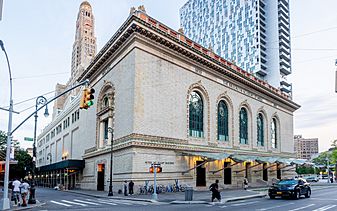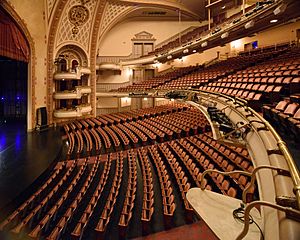Brooklyn Academy of Music facts for kids
|
BAM
|
|

BAM Peter Jay Sharp Building (2019)
|
|
| Address | 30 Lafayette Avenue (Peter Jay Sharp) 651 Fulton Street (BAM Strong) 321 Ashland Place (Fisher) |
|---|---|
| Location | Brooklyn, New York |
| Public transit | New York City Subway: |
| Type | Performing arts center |
| Capacity | Howard Gilman Opera House: 2,109 Harvey Theater: 874 Lepercq Space: 350 Fishman Space: 250 Total: 3,583 |
| Construction | |
| Built | 1908 |
| Opened | 1908 |
|
Brooklyn Academy of Music
|
|
| Location | 30 Lafayette Ave., Brooklyn, New York |
| Area | less than one acre |
| Built | 1907 |
| Architect | Herts & Tallant |
| Architectural style | Renaissance |
| NRHP reference No. | 06000251 |
| Added to NRHP | May 2, 2006 |
The Brooklyn Academy of Music (BAM) is a famous place in Brooklyn, New York City, where you can see many different kinds of art. It's a "multi-arts center." BAM shows exciting and new performances like theater plays, dance shows, music concerts, operas, and movies. These events happen in several buildings close to each other.
BAM was officially started in 1859. Its first show was in 1861. The current main building in Fort Greene, Brooklyn, opened in 1908. BAM is a not-for-profit group in New York State. Gina Duncan has been the president since April 2022. David Binder became the artistic director in 2019.
Contents
History of the Brooklyn Academy of Music
The First BAM Building
On October 21, 1858, a group met to talk about building a large hall. They wanted a place for music, talks, science events, and other gatherings. They wanted it to be big enough for Brooklyn's growing population. This group asked the New York State Legislature for permission to create the Brooklyn Academy of Music.
The New York Legislature approved the plan on February 16, 1859. The group quickly raised money, getting $60,000 by November 22, 1858, and another $90,000 by March 16, 1859. The first Brooklyn Academy of Music opened its doors on January 15, 1861.
At the opening, the managers said that no plays would ever be performed there. The first concert started with music from an opera called Der Freischütz. It also included songs and parts from other operas, like the William Tell Overture.
The first BAM building was at 176–194 Montague Street in Brooklyn Heights. It was meant to be the home of the Philharmonic Society of Brooklyn. The building was designed by architect Leopold Eidlitz. It had a large theater with 2,109 seats. There was also a smaller concert hall, dressing rooms, and a big kitchen. BAM hosted both amateur and professional music and theater shows. Famous performers like Ellen Terry and Edwin Booth appeared there.
BAM's Current Home
The first BAM building burned down on November 30, 1903. After this, BAM decided to move to a new location in Fort Greene, Brooklyn. The new building was designed by the architects Herts & Tallant. The first stone for the new building was placed at 30 Lafayette Avenue on May 25, 1907.
A series of opening events took place in November 1908. The first opera performed there was Faust by the Metropolitan Opera. In the early 1900s, the building was also used for religious services. Charles Taze Russell, who started the Bible Students movement, gave talks there.
BAM from the 1960s to 1990s
The Waltann School of Creative Arts (WSCA) was a BAM location in the 1960s and 1970s. Carole Johnson, a modern dancer, taught there. The Eleo Pomare Dance Company performed there in 1967.
In 1967, Harvey Lichtenstein became the executive director. For 32 years, he helped BAM become very popular. He brought in new and exciting shows and helped BAM raise money. BAM even started a special bus service, the BAMbus, in 1968 to bring people from Manhattan. In 1983, BAM began its yearly Next Wave Festival. This festival showed performances by artists from all over the world.
The Chelsea Theater Center was based at BAM from 1967 to 1977. The Harvey Theater, another important BAM venue, was finished in 1987.
BAM from the 2000s to Today
From 1999 to 2015, Karen Brooks Hopkins was president. Joseph V. Melillo was the executive producer until 2018. The outside of the main building at 30 Lafayette Avenue was repaired in 2004. This cost $8.6 million. The BAMbus service stopped in 2013 because not enough people were using it.
In 2012, BAM opened its Richard B. Fisher Building. This building has a 250-seat experimental theater. A regular event there was BAMcinemaFest, which showed independent films. Katy Clark was president from 2015 to 2021. The BAM Strong complex opened in October 2019. At the same time, the Harvey Theater was also renovated.
The COVID-19 pandemic caused financial problems for BAM. A new space called BAM KBH, which has a black box theater and an archives area, opened in early 2025. The New York Times noted in 2025 that many of BAM's past leaders stayed for a long time. However, their recent replacements have left after only a few years.
Artists and Performances at BAM
Many famous artists have performed at BAM. These include Philip Glass, Pina Bausch, Merce Cunningham, Laurie Anderson, and Steve Reich. The Mariinsky Theater has also presented work there.
Some music groups have recorded live albums at BAM. The American punk band Hole recorded their MTV Unplugged album there on February 14, 1995. Alice in Chains also recorded their live album Unplugged at the Harvey Theater on April 10, 1996. Alanis Morissette recorded her MTV Unplugged album at BAM on September 18, 1999.
BAM's Buildings and Spaces
The Peter Jay Sharp Building is in the Fort Greene Historic District. It holds the Howard Gilman Opera House and the BAM Rose Cinemas. The firm Herts & Tallant designed it in 1908. It is built in the renaissance revival style. The building has a strong base of gray granite. Above that, it has cream-colored brick with terracotta and some marble details.
The Howard Gilman Opera House has 2,109 seats. BAM Rose Cinemas opened in 1998. It has four screens and mostly shows new, independent, and classic films.
Also inside the Peter Jay Sharp Building is the Lepercq Space. This used to be a ballroom. Now, it's a flexible space for events and houses the BAMcafé. The Hillman Attic Studio is another flexible space for rehearsals and performances.
The BAM Strong is a group of spaces. It includes the 874-seat BAM Harvey Theater at 651 Fulton Street. This theater was once called the Majestic Theater. It was built in 1904 and had 1,708 seats. It showed vaudeville acts and then movies. In 1999, it was named after Harvey Lichtenstein.
When the Harvey Theater was renovated by architect Hugh Hardy, its inside was left with faded paint and exposed brick. This gives the theater a unique look, like a "modern ruin." In April 2014, CNN called the BAM Harvey one of the "15 of the World's Most Spectacular Theaters." The BAM Strong complex also has a special art gallery.
The BAM Fisher Building opened in 2012. It has the Fishman Space, which is a 250-seat black box theater. It also has the Fisher Hillman Studio, a flexible space for rehearsals and performances. The building also holds BAM's offices. The BAM Hamm Archives are in Crown Heights. They keep the Levy Digital Archive, which is open to the public.
The BAM Sharp and Fisher Buildings are part of the Brooklyn Academy of Music Historic District. This district was created in 1978. The BAM Strong building is not part of this district. BAM is close to downtown Brooklyn, near Atlantic Terminal, the Barclays Center arena, and the Williamsburgh Savings Bank Tower. BAM is an important part of the Brooklyn Cultural District.
Famous Shows at BAM
| Year | Title | Playwright | Cast | Ref. |
|---|---|---|---|---|
| 2024 | A Streetcar Named Desire | Tennessee Williams | Paul Mescal | |
| 2023 | The Sign in Sidney Brustein's Window | Lorraine Hansberry | Oscar Isaac and Rachel Brosnahan | |
| 2022 | Cyrano | Edmond Rostand | James McAvoy | |
| 2020 | Medea | Euripides | Bobby Cannavale and Rose Byrne | |
| 2016 | The Judas Kiss | David Hare | Rupert Everett | |
| 2016 | Richard II / Henry V | William Shakespeare | David Tennant | |
| 2014 | King Lear | William Shakespeare | Frank Langella | |
| 2011 | Diary of a Madman | Nikolai Gogol | Geoffrey Rush | |
| 2009 | A Streetcar Named Desire | Tennessee Williams | Cate Blanchett | |
| 2008 | Macbeth | William Shakespeare | Patrick Stewart |
See also
 In Spanish: Academia de Música de Brooklyn para niños
In Spanish: Academia de Música de Brooklyn para niños




